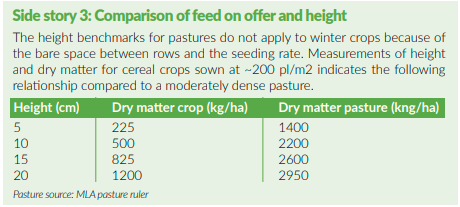The almost forgotten technique in the UK of grazing cereals is something being widely practiced across Australia in areas with widely varying rainfall levels. The Australian Grain Research and Development Council have produced a report titled Grain and Graze which sets out to evaluate the advantages and disadvantages of grazing a range of cash crops. We begin serializing this report over coming issues to explore what is currently an untapped resource.
Originally Published by Grain and Graze in Australia in 2016
The opportunities and potential downsides of grazing winter crops (why do it?)
Grazing winter crops is practiced across 19,000 mixed farms in Southern and Western Australia. In 2013 more than 2.7 million hectares of crop were grazed, representing 12% of the total area of crop grown. However the area grazed fluctuates from year to year, suggesting that grazing crops are often used as an opportunistic feed source rather than an annual feed supply. Suitable winter crops have commonly been referenced as ‘dual purpose’ because they can be used successfully for grazing and grain. Yet just because a crop variety may not have the tag ‘dual purpose’ does not mean it cannot be used for both purposes (refer to side story 1).

Balancing the benefits and the costs The decision to graze winter crops requires weighing up the potential benefits to the farming system against the potential losses. The most obvious opportunity in a mixed farming system is to graze the crop when it is tillering, eating the leaves at the time of year when other feed is often in short supply. The greatest potential downside is the reduction in grain yield as a result of this grazing.
Examination of trial data from 193 comparisons in the high rainfall and medium to low rainfall environments shows a big range in dry matter production and impact on grain yield from grazing compared to no grazing (figures 1 & 2). These results are sourced from a range of years, cereal types, varieties, sowing dates and grazing approaches, so present both ‘good’ and ‘poor’ practice. Importantly it shows the opportunity for valuable dry matter production with minimal or no impact on grain yield if certain management choices and environmental conditions are met.
It also highlights the potential losses when circumstances are unfavourable.
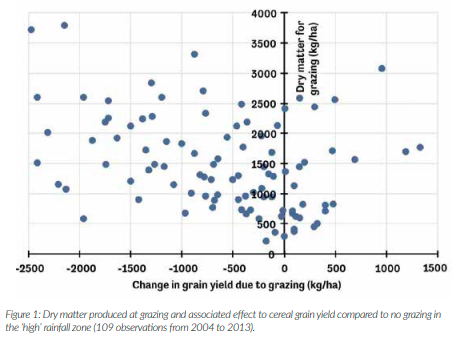
However, the decision to grow and graze winter crops is more complex than just comparing dry matter against grain yield. Each individual farmer needs to evaluate the full range of potential benefits and costs associated with grazing winter crops to help decide if the opportunities outweigh the risks. The possible benefits and costs identified by farmers who have experience in grazing crops are summarised below. Greater discussion will be provided in further issues of Direct Driller.
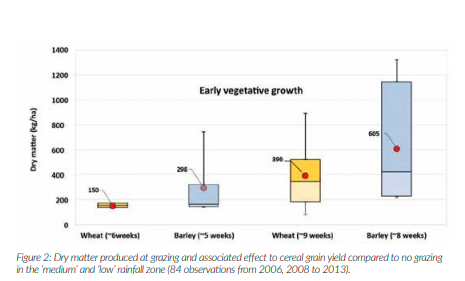
Value to the livestock operation
• Provides high quality feed when fodder is often in short supply or replaces supplementary feeding
• Allows pastures to be rested to build a wedge of feed for use later in the year or for new pastures to establish
• Provides a worm free grazing environment
• Provides a place for animals to be ‘parked’ while pastures are treated with herbicides.
Costs to the livestock operation
• Grazing wheat crops for extended periods will require mineral supplementation
• May result in increased metabolic disorders, particularly with ewes in late pregnancy
• May require temporary fencing to ensure appropriate grazing
• Mobs may need to be ‘boxed’ to get adequate grazing pressure across a short time frame.
Value to the cropping operation
• Enables excessive crop canopies to be managed, reducing possible lodging, incidence of leaf diseases and future stubble loads
• Conserves soil moisture that can be used by the crop later in the year
• Delays maturity which may avoid late frosts
• Can improve the efficacy of some herbicide treatments e.g. broadleaf weed control and weed control e.g. selective grazing of grasses from oilseed or legume crops.

The possible benefits (the upside)
Extra feed for grazing The greatest upside with grazing crops is the additional high quality feed that is available in the winter period. The most common uses of this extra feed is to: • Fill a winter feed deficit, avoiding underfeeding, reducing the need for supplementation or the need to sell stock at low prices
• Provide the opportunity to ‘punt’ and trade stock, by purchasing at times of low prices
• To ‘spell’ pastures from grazing, enabling them to ‘get away’ and reach pasture benchmarks for lambing or calving.
Examination of more than 500 measurements from 80 grazing crops trials conducted through Grain and Graze program over the past decade show a wide range in dry matter production. This variability is influenced by climatic conditions, type of crop, sowing rate, time from sowing to grazing and use of fertiliser, especially nitrogen. To convey the variability in dry matter production, ‘box and whisker’ graphs and percentiles are used to summarise the information (see side story 2 on interpreting box and whisker graphs). Results for wheat, barley and canola are grouped around vegetative growth in low and high rainfall zones and for the start of stem elongation (high rainfall zone only) (figures 3 to 5). The dry matter values are also presented in percentile tables (appendix 1).
Figures 3, 4 and 5 highlight a number of general, if not predictable, observations:
• Dry matter production is much greater in the high rainfall zone than the low rainfall zone for similar days from sowing. Rainfall, sowing rate and row spacing has a large influence on the measured difference.
• Barley provides more rapid early growth than spring or winter wheats or canola.
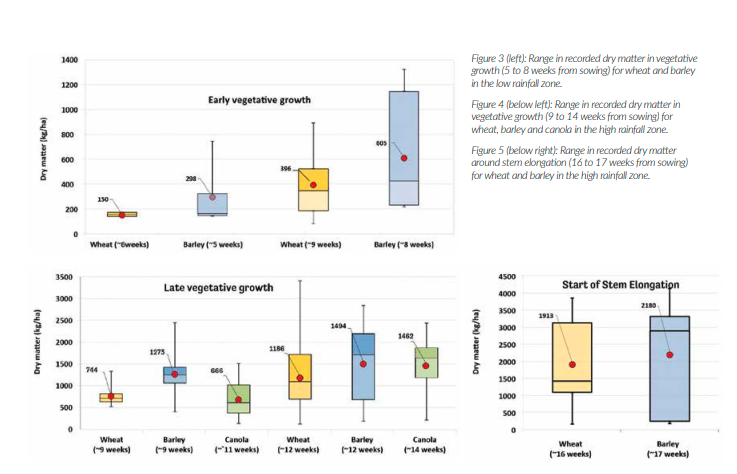
• Varieties within spring wheats, winter wheats or barley have much lesser influence on total dry matter when compared at the same sowing time, sowing rate and climatic conditions. This is not so canola, where hybrid varieties grow more rapidly under the same conditions.
• As the days from sowing increases so does the average dry matter production, however the range in dry matter production widens (seen by the taller boxes and longer whiskers).
High feed quality
Winter crops offer high quality feed which is equivalent or higher than typical pastures at the same time of year. Canola is slightly higher than the cereals in digestibility and metabolisable energy (figures 6 & 7). Digestibility and energy in the cereals appear to peak in the late vegetative stage and declines once stem elongation commences. The protein content of all winter crops is very high in early vegetative growth, but declines as the crop matures, although the minimum protein levels remain well above the requirements of any class of livestock (figure 10). Maximum protein requirements for lactating or growing animal is around 14% to 16%. Animals are unable to store excess dietary protein, so any surplus protein is excreted by the animal in urine.
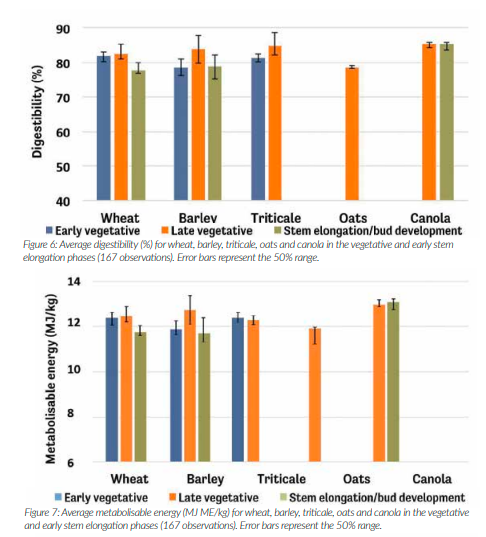
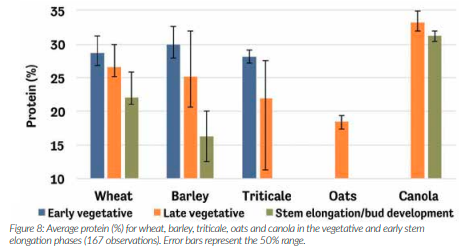
Potentially high animal growth rates
The performance of animals grazing winter crops (or pasture) is influenced by the quality of feed eaten and the amount available for grazing. Cereals and canola tend to be less dense and grow more upright than pasture. This means it is much easier for a grazing animal to consume a greater quantity of feed for each bite with a winter crop than with a pasture, even though the total feed on offer (if cut to ground level) is the same or less (see side story 3 on comparison of feed on offer and height). The difference in grazing height and the high quality of the winter crop has a considerable impact on intake and animal performance.
